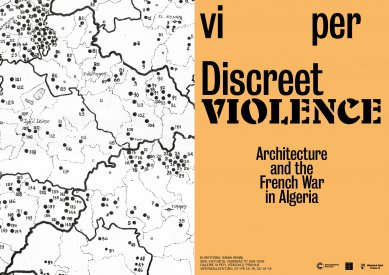
Hidden Violence: Architecture and the French War in Algeria
Gallery VI PER, Vítkova 2, Prague 8
26/9–10/11/2018
Opening 25/9, 19:00
During the Algerian Revolution (1954–1962), also known as the Algerian War of Independence, French civil and military authorities fundamentally reorganized urban and rural areas of Algeria, drastically transformed its built environment, rapidly constructed new infrastructure, and established new settlements in strategic locations. The aim of all this was to protect French economic interests in Algeria and to maintain Algeria under French colonial rule, which had existed since 1830.
This exhibition addresses only one aspect of these territorial transformations, namely the construction of military-controlled camps, nicknamed centres de regroupement (re-grouping or assembly centers), situated in the rural areas of Algeria. The creation of these spaces stemmed from the establishment of forbidden zones – areas that allowed unrestricted use of firearms – and triggered massive forced resettlement of local populations. Special military units, called Sections administratives spécialisées (SAS, Specialized Administrative Sections), oversaw the evacuation of forbidden zones, the reconfiguration of the Algerian population, the building of temporary and permanent camps, and the transformation of a large number of permanent camps into villages, while simultaneously monitoring the daily lives of Algerian civilians. The goal of this reconfiguration was to separate Algerians from the influence of national liberation fighters and to complicate their potential psychological and material support. The exact number of camps built during the war, the people forced to leave their homes, or the destroyed villages is still debated today.
The exhibition Concealed Violence: Architecture and the French War in Algeria draws on French military photographs and films produced by the propaganda teams of the Service cinématographique des armées (SCA, Army Cinematographic Office) and from other public and private sources. It focuses on certain aspects of the evacuation of the Algerian rural population and the construction processes and living conditions in the mentioned camps. It unveils the methods by which the French colonial government attempted to shift the military purpose of the camps in response to the media scandal of 1959. It reveals the internal relationships between architecture, military measures, colonial politics, and the planned production and distribution of visual records.
Samia Henni serves as a professor of the history of architecture and urban development at Cornell University. She is the author of the book Architecture of Counterrevolution: The French Army in Northern Algeria (gta Verlag, Zurich 2017).
Acknowledgments: Michel Cornaton, Mary McLeod, Lucie Moriceau, Véronique Pontillon, Sabine Sarwa, Nadine Schütz, Pascal Schwaighofer, Daniel Sommer, Philip Ursprung, Damien Vitry, Clément Willemin, Pierre Willemin
More information >
26/9–10/11/2018
Opening 25/9, 19:00
Curator: Samia Henni
This exhibition addresses only one aspect of these territorial transformations, namely the construction of military-controlled camps, nicknamed centres de regroupement (re-grouping or assembly centers), situated in the rural areas of Algeria. The creation of these spaces stemmed from the establishment of forbidden zones – areas that allowed unrestricted use of firearms – and triggered massive forced resettlement of local populations. Special military units, called Sections administratives spécialisées (SAS, Specialized Administrative Sections), oversaw the evacuation of forbidden zones, the reconfiguration of the Algerian population, the building of temporary and permanent camps, and the transformation of a large number of permanent camps into villages, while simultaneously monitoring the daily lives of Algerian civilians. The goal of this reconfiguration was to separate Algerians from the influence of national liberation fighters and to complicate their potential psychological and material support. The exact number of camps built during the war, the people forced to leave their homes, or the destroyed villages is still debated today.
The exhibition Concealed Violence: Architecture and the French War in Algeria draws on French military photographs and films produced by the propaganda teams of the Service cinématographique des armées (SCA, Army Cinematographic Office) and from other public and private sources. It focuses on certain aspects of the evacuation of the Algerian rural population and the construction processes and living conditions in the mentioned camps. It unveils the methods by which the French colonial government attempted to shift the military purpose of the camps in response to the media scandal of 1959. It reveals the internal relationships between architecture, military measures, colonial politics, and the planned production and distribution of visual records.
Samia Henni serves as a professor of the history of architecture and urban development at Cornell University. She is the author of the book Architecture of Counterrevolution: The French Army in Northern Algeria (gta Verlag, Zurich 2017).
Acknowledgments: Michel Cornaton, Mary McLeod, Lucie Moriceau, Véronique Pontillon, Sabine Sarwa, Nadine Schütz, Pascal Schwaighofer, Daniel Sommer, Philip Ursprung, Damien Vitry, Clément Willemin, Pierre Willemin
More information >
The English translation is powered by AI tool. Switch to Czech to view the original text source.

0 comments
add comment
Related articles
0
19.11.2018 | f-architecture: Cosmo-Clinical Interiors of Beirut
0
02.11.2018 | Samia Henni: Architecture of Counterrevolution
0
07.05.2018 | The form follows the money - an exhibition at Gallery VI PER
0
11.04.2018 | Simone Rowat: Forensic Aesthetics
0
21.03.2018 | Diffractions Collective: The Drone and Urban Space
0
30.09.2017 | Pub U hada in Gallery VI PER











